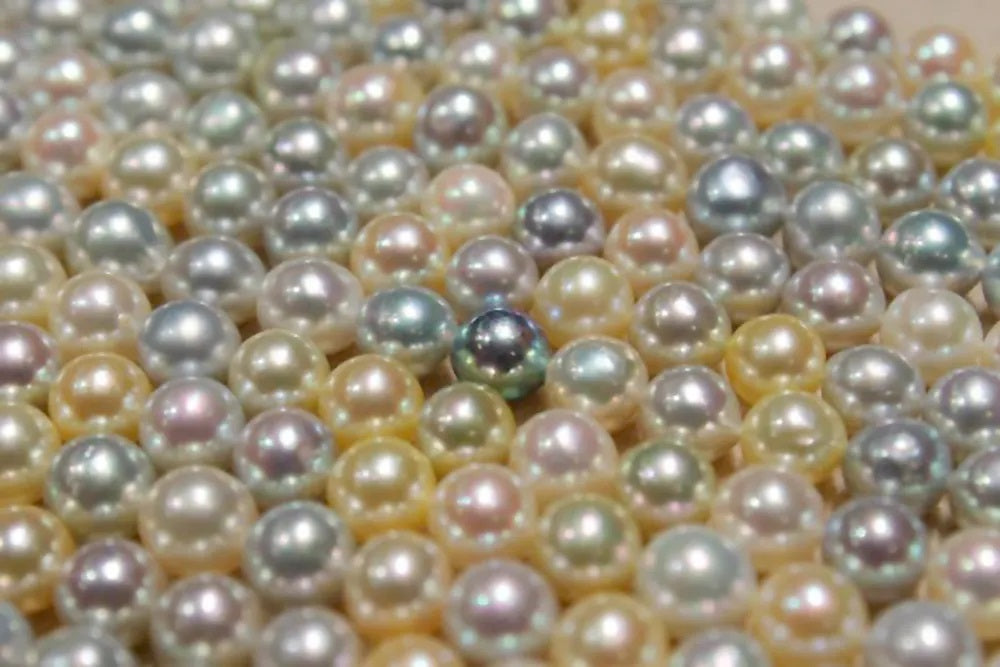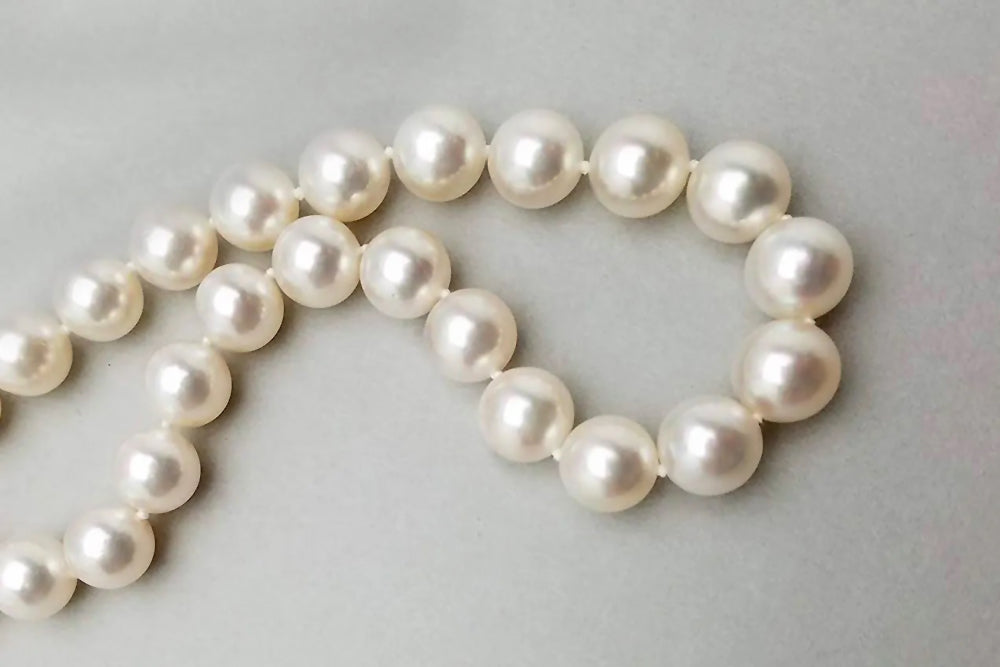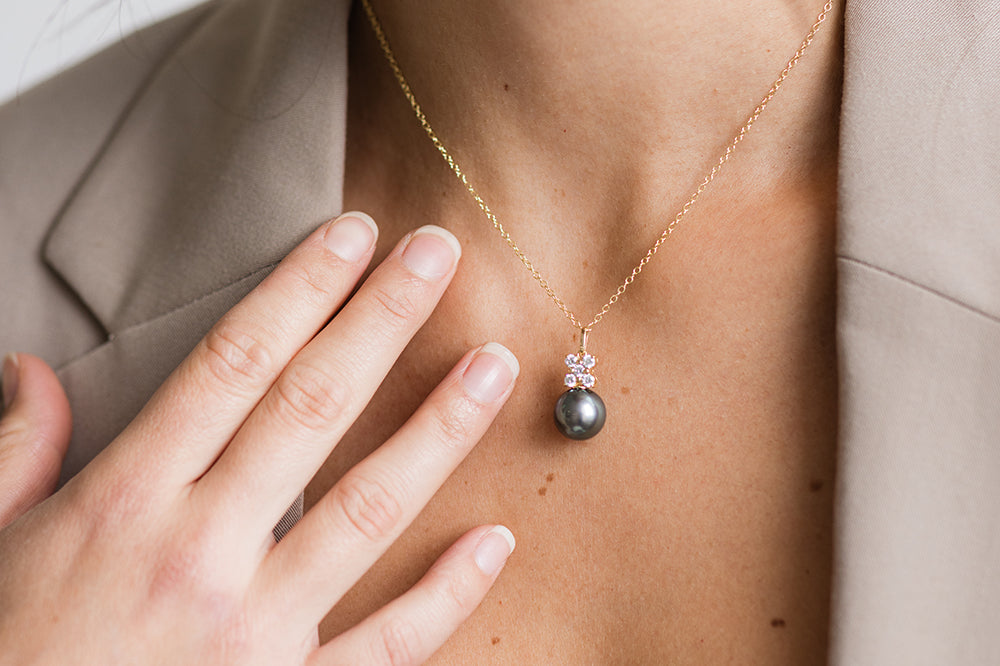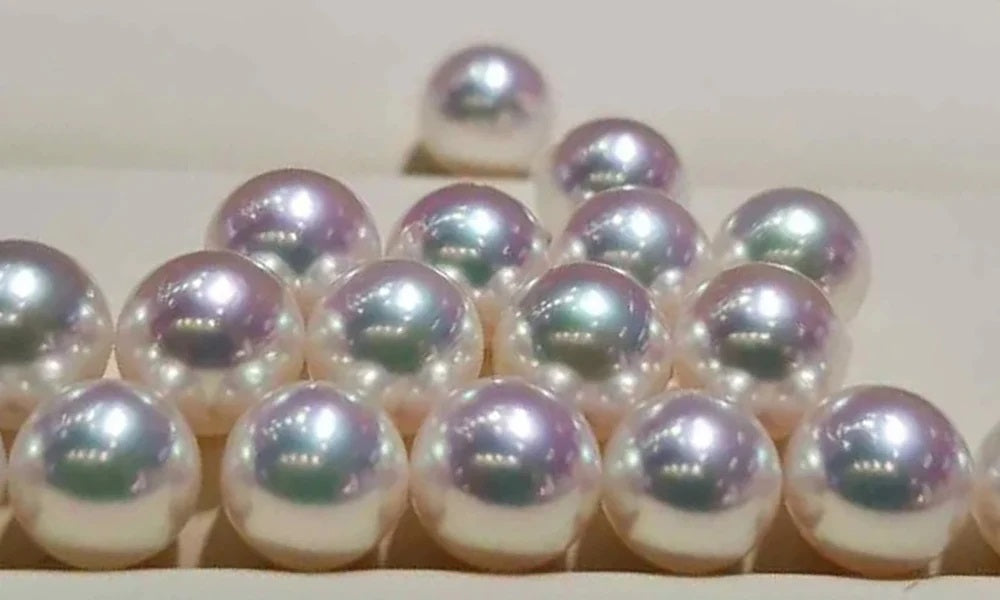Eye Candy
ENDLESS ORIENT
Absolutely stunning freeform Baroque Freshwater pearl necklace featuring intense rainbow orient on every single pearl surface. Yum!
You Asked ...
Every day we receive questions from customers all over the world about pearls. We decided to post our answers here for every one to read!
How Do I Tell if a Pearl Necklace is High Quality?
We Answer:
With pearls being such a specialized niche within the jewelry industry, it can be tough for shoppers to know how to look at and evaluate a pearl necklace and know whether or not they're getting high quality pearls.
This blog post will deal with evaluating pearls using the 7 Value Factors, and include plenty of up-close pictures for an easy visual guide of what to look for when buying pearls.
Close up of fine Hanadama Akoya pearls
Luster!
This is easily the most important Value Factor to look at when inspecting a pearl necklace. A pearl without luster is really just a dull, chalky round bead, which is not what any one is after!
What to Look For: High-quality pearls have a bright, mirror-like shine. The more radiant and reflective the surface, the higher the quality. You want the edges of reflected light sources to be sharp, crisp and cleanly delineated.
Test: Hold the necklace under good lighting. Do the pearls glow and reflect light sharply, or do they appear dull?
Can you see your face reflected in the pearl's surface, or other objects? If so, how much is easily recognizable? Are the reflections "mirror-like", slightly blurred or just totally unrecognizable blobs?
Surface Quality:
The second most important (and it's a very close second!) factor to look at is whether or not the pearls are smooth and clean, or have blemishes or growth characteristics that disrupt the pearl's smooth reflection of light.
What to Look For: Fewer blemishes or imperfections (e.g., spots, bumps, pits). Pearls with smooth, clean surfaces are more valuable.
Test: Examine the pearls closely, ideally on a plain white piece of paper in mid-morning indirect sunlight. You want to slowly roll small sections of the strand (about 1 to 2-inches at a time), and carefully examine the pearls from a distance of 6-inches or less. Carefully note the amount of inclusions, their location and how large/deep they are.
Remember that imperfections are natural, and in some ways are even beneficial, in that they can both serve as an organic testament that your pearls are genuine cultured pearls, and each strand of pearls has their own unique inclusions which can serve as an in-built identification system. So no, not all imperfections are bad, but they should be minimal.
Close up of AAA Quality Freshwater pearls, with an off-round to ovalish shape.
Shape
The gold standard when it comes to a pearl's shape is perfectly round. Perfectly round pearls are the rarest (especially when it comes to natural pearls found in the wild!), and give the pearl that smooth, evenly rolling surface that marks them as unique in the world of gemstones.
Not all pearls "need" to be perfectly round, however! Smooth, tear-drop shapes are highly coveted for their romantic aesthetic appeal, and baroque pearls (pearls that are circled, free-form and asymmetrical) are loved for their unique, artistic appeal. But on the whole, the perfectly round pearls are going to be more valuable because they are the rarest of all pearl shapes.
What to Look For: Perfectly round pearls are rare and highly prized. However, other shapes like baroque or oval can also be valuable if they are symmetrical and appealing. Drop shaped pearls should feature smooth, beautifully symmetrical surfaces. Freshwater pearls in particular have a very wide range of shapes, ranging from freeform baroque to drops and ovals, to off-round and slightly egg-shaped (see above), and most rare: perfect rounds.
Test: Roll the pearls on a flat surface. Perfectly round pearls will roll evenly in eight directions without wobble. If the pearls are knotted in a necklace, as with the Surface Quality inspection mentioned previously, you'll want to gently roll sections of the strand back in forth in front of you on a flat surface and carefully observe if you are seeing any "wobble".

Craftsmanship
A high-quality pearl necklace or pearl bracelet should feature smooth, tight knot work on durable silk thread, with 14K gold French wire-wrapping used to secure the strand at each end of the clasp. This ensures the necklace is not only elegant but also well-protected, as the knots between each pearl prevent rubbing, and loss if the strand breaks.
While tight knotting is essential for maintaining the integrity of the pearls, overly tight knots can occasionally cause the necklace to kink, or look misshapen. This is a natural occurrence and not a flaw.
To get your necklace to lay smoothly this, gently grasp the pearls near the clasp, and slowly pull down, running your fingers over each pearl in the necklace, relaxing the tension in the silk. You may need to do this one or more times. Another solution is to lay the pearl strand on a countertop in your bathroom while taking a shower (do NOT hang!). The steam from the shower will absorb into the silk, and gently relax the knotwork.
Proper knotting and finishing enhance the necklace’s durability and beauty, ensuring it lasts for generations.

Matching
Pearl matching is a critical factor in assessing the quality of a pearl necklace, especially in single-color strands like Akoya or white Freshwater pearl necklaces.
High-quality necklaces feature pearls that are uniform in size, shape, color, luster, and surface quality. Even slight inconsistencies can disrupt the harmony and elegance of the necklace.
Matching pearls requires expert craftsmanship and a trained eye to ensure that the strand appears cohesive and balanced when worn. This meticulous attention to detail not only enhances the necklace's aesthetic appeal but also reflects its overall value and the skill involved in its creation.

Pearls of varying hues—such as white, pink, and lavender or gold and black—must be arranged in a way that complements the other and creates a visually appealing flow. The transition between colors should feel natural and balanced, avoiding harsh contrasts unless intended as a design feature.
Additionally, luster and surface quality must be consistent across the strand to ensure unity. Thoughtful color placement enhances the overall appeal, capturing the buyer's eye and making the necklace a standout piece. This blend of technical expertise and artistic sensibility defines the allure of multi-color pearl jewelry.
What to Look For: In a necklace, the pearls should be uniform in size, shape, color, and luster.
Test: Lay the necklace flat. Does it appear harmonious, or do certain pearls stand out with lighter or deeper overtones that don't quite match? Examine the strand overall: is it cohesive, and "speak" to you of an ideal or an aesthetic that you love, or is it disjointed and jarring?
When determining the quality of a pearl necklace, each value factor—luster, surface, shape, matching, the quality of stringing and overall craftsmanship—plays a crucial role.
High-quality pearls should exhibit gorgeous luster, smooth surfaces with minimal inclusions, and near-perfect matching in shape and size (or thoughtful variation in the case of multi-color designs). Durable stringing, secured with 14K gold French wire-wrapping, and a balanced design reflect that expert craftsmanship that is sure to last.
Weekly Video
Featured Pearls

Hanadama Akoya Pearl Necklace, 8.0-8.5mm
Popularly known as "Flower Pearls" for their delicate to deep rose overtones, each Hanadama Japanese Akoya Pearl Necklace features some of the most brilliant, luminous luster ever seen. Graduating from 8.0-8.5mm, this Hanadama Pearl Necklace exudes timeless elegance.
Featuring the thickest nacre of any Akoya pearl in the world, our hand-crafted Hanadama Pearl Necklaces are individually double-knotted by hand on fine white silk, and is finished with a 14K Gold Clasp of your choice. Every Hanadama Necklace is hand-made to order here at our Los Angeles, CA workshop.
Each Hanadama Collection Necklace arrives with its own numbered Pearl Science Laboratory certificate from Tokyo, Japan, detailing the pearls' surface quality, nacre thickness and x-ray results. Your new Hanadama Akoya Pearl Necklace arrives secured in a fine Jewelry Presentation Box for you to keep and is accompanied by a certificate of authenticity and Pearl Care Instructions.

![]()
![]()























































